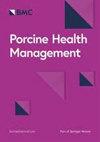Factors contributing to high performance of sows in free farrowing systems
IF 3.1
2区 农林科学
Q1 VETERINARY SCIENCES
引用次数: 0
Abstract
Pressure to abolish farrowing crates is increasing, and producers are faced with decisions about which alternative system to adopt. For sow welfare, well designed free farrowing systems without close confinement are considered optimal but producers have concerns about increased piglet mortality, particularly crushing by the sow. Reporting accurate performance figures from commercial farms newly operating such systems could inform the transition process. This study investigated performance on three commercial farms operating four different zero-confinement systems, three of which were newly installed. A total of 3212 litters from 2920 sows were followed from farrowing to weaning over a three-year period with key performance indicators (KPIs) recorded. Mixed Models (LMMs, GLMMs) determined the influence of different factors (e.g. farrowing system, sow parity, management aspects) and litter characteristics on performance, including levels and causes of piglet mortality. Piglet mortality was significantly influenced by farm/system. Live-born mortality ranged from 10.3 to 20.6% with stillbirths ranging from 2.5 to 5.9%. A larger litter size and higher parity resulted in higher levels of mortality regardless of system. In all systems, crushing was the main cause of piglet mortality (59%), but 31% of sows did not crush any piglets, whilst 26% crushed only one piglet and the remaining sows (43%) crushed two or more piglets. System significantly influenced crushing as a percentage of all deaths, with the system with the smallest spatial footprint (m2) compared to the other systems, recording the highest levels of crushing. Time from the start of the study influenced mortality, with significant reductions in crushing mortality (by ~ 4%) over the course of the three-year study. There was a highly significant effect of length of time (days) between moving sows into the farrowing accommodation and sows farrowing on piglet mortality (P < 0.001). The less time between sows moving in and farrowing, the higher the levels of piglet mortality, with ~ 3% increase in total mortality every five days. System effects were highly significant after adjusting for parity, litter size, and days pre-farrowing. These results from commercial farms demonstrate that even sows that have not been specifically selected for free farrowing are able, in many cases, to perform well in these zero-confinement systems, but that a period of adaptation is to be expected for overall farm performance. There are performance differences between the farms/systems which can be attributed to individual farm/system characteristics (e.g. pen design and management, staff expertise, pig genotypes, etc.). Higher parity sows and those producing very large litters provide a greater challenge to piglet mortality in these free farrowing systems (just as they do in crate systems). Management significantly influences performance, and ensuring sows have plenty of time to acclimatise between moving in to farrowing accommodation and giving birth is a critical aspect of improving piglet survival.自由产仔系统中母猪生产性能高的因素
废除产房的压力与日俱增,生产商面临着采用哪种替代系统的抉择。就母猪福利而言,设计精良的非密闭式自由产仔系统被认为是最佳选择,但生产商担心仔猪死亡率增加,尤其是母猪的挤压。报告新近运行此类系统的商业猪场的准确性能数据可为过渡进程提供参考。本研究调查了三个商业化猪场的生产性能,这些猪场采用了四种不同的零圈养系统,其中三种是新安装的。从产仔到断奶,共对 2920 头母猪的 3212 窝仔猪进行了为期三年的跟踪,并记录了关键绩效指标 (KPI)。混合模型(LMMs、GLMMs)确定了不同因素(如产仔系统、母猪奇偶性、管理方面)和窝仔猪特征对生产性能的影响,包括仔猪死亡率水平和原因。猪场/系统对仔猪死亡率有明显影响。活产死亡率从 10.3% 到 20.6%不等,死胎率从 2.5% 到 5.9%不等。无论采用哪种饲养模式,窝产仔数越大、奇数越多,死亡率越高。在所有系统中,挤压是仔猪死亡的主要原因(59%),但 31% 的母猪没有挤压过任何仔猪,26% 的母猪只挤压过一头仔猪,其余母猪(43%)挤压过两头或更多仔猪。与其他系统相比,空间足迹(平方米)最小的系统记录的挤压程度最高。研究开始的时间对死亡率有影响,在为期三年的研究过程中,挤压死亡率显著降低(约 4%)。从母猪移入产房到母猪分娩之间的时间长度(天数)对仔猪死亡率有非常显著的影响(P < 0.001)。母猪从进入产房到分娩的时间越短,仔猪死亡率越高,每五天总死亡率增加约 3%。在对胎次、窝产仔数和产仔前天数进行调整后,系统效应非常显著。这些来自商业化猪场的结果表明,即使母猪没有经过专门挑选用于自由产仔,在许多情况下也能在这些零隔离系统中表现出色,但对猪场的整体表现而言,需要一个适应期。不同猪场/系统之间存在性能差异,这可归因于各个猪场/系统的特点(如栏舍设计和管理、员工专业知识、猪的基因型等)。在自由产仔系统中,高产仔数母猪和产仔数多的母猪对仔猪死亡率提出了更高的挑战(正如在笼养系统中一样)。管理对生产性能的影响很大,确保母猪在进入产房和分娩之间有充足的适应时间是提高仔猪存活率的关键。
本文章由计算机程序翻译,如有差异,请以英文原文为准。
求助全文
约1分钟内获得全文
求助全文
来源期刊

Porcine Health Management
Veterinary-Food Animals
CiteScore
5.40
自引率
5.90%
发文量
49
审稿时长
14 weeks
期刊介绍:
Porcine Health Management (PHM) is an open access peer-reviewed journal that aims to publish relevant, novel and revised information regarding all aspects of swine health medicine and production.
 求助内容:
求助内容: 应助结果提醒方式:
应助结果提醒方式:


